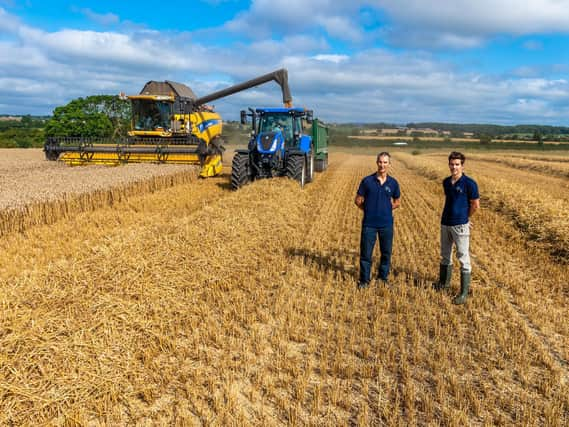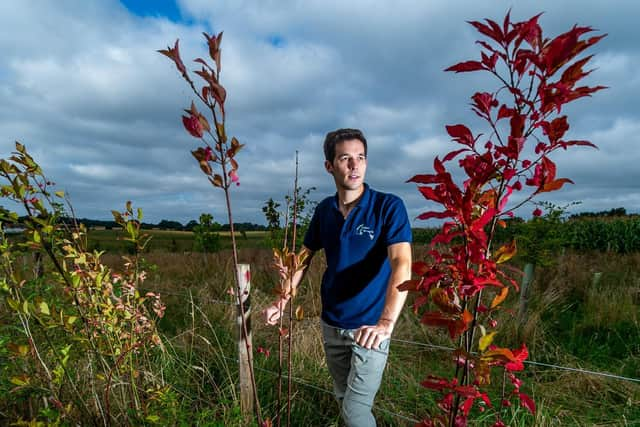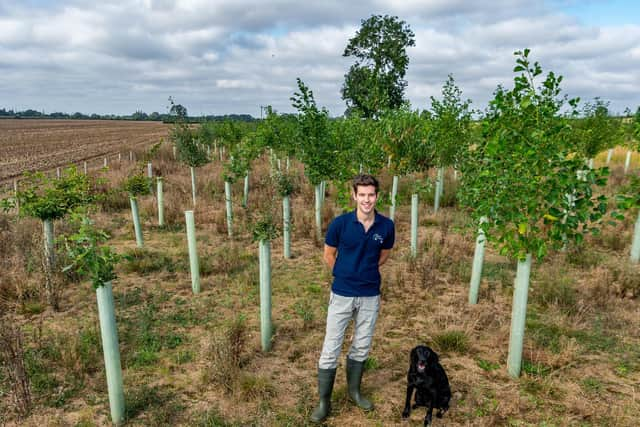Farm of the Week: Restoring woodland and hedgerows on land near Northallerton that had just five trees and aiming for net zero


Daniel Blenkiron is a third-generation farmer, working alongside his father Keith at the home farm of Lark Hall Farm near Northallerton and at Longlands Farm where he lives three miles away.
Recently, Daniel was rewarded for his efforts in planting new hedgerows by the National Farmers Union, after having planted 650 metres around the farmstead and as a new hedgeline from the farm entrance at Lark Hall. Daniel said the work that has been undertaken over the past three years in hedgerow establishment and planting 6,000 saplings, concentrating on native trees, was already proving rewarding environmentally.
Advertisement
Hide AdAdvertisement
Hide Ad“We have seen an increase in English grey partridge numbers on both farmsteads. The species was in decline at them previously. We have also seen an even larger increase in the number of common birds that are finding the hedges a valuable shelter and feed source, particularly from the wild berries produced.


“We started with the planting of new trees as part of countryside stewardship through the woodland creation and maintenance grant in autumn 2018. I had always wanted to do something with trees creating shelter belts, screenings and utilising land that didn’t perform for our arable cropping.
“At Longlands it was about shaping the farm for the future. There were only five trees on the whole farmstead when we took it on. I have a combined passion for agriculture and nature, and trees and hedgerows have an important role to play in preserving and maintaining wildlife ecosystems.”
Daniel said he has created new woodlands using a mix of UK species..
Advertisement
Hide AdAdvertisement
Hide Ad“We have planted oak, rowan or mountain ash, hornbeam, field maple, silver birch, Scots pine as they maintain their needles, sycamore, alder and poplar. Each has its own strengths and benefits to wildlife. We’ve also planted wild cherry trees that also act as a wildlife feed source.”


Having graduated from Harper Adams in 2012 Daniel said he had set his mind on how new technologies that include the utilisation of digestate, livestock manure and a new combustion plant can provide new green energies that can make the farm business more sustainable in the long term.
“Digestate is a game changer for our arable enterprise and it is already quite noticeable how our winter crops are much deeper, rich and a greener colour from its application. We are adding nitrogen, phosphate and potash all in one go. It has a good blend of nutrients and we are saving on liquid fertiliser and maintaining soil fertility.
“We completed our litter combustion plant in 2017 using poultry manure as a fuel source. It works by using the dry material produced that when burned provides heat through a biomass plant, which in turn creates a much healthier and safer environment for the poultry rather than using other more traditional energies such as gas.
Advertisement
Hide AdAdvertisement
Hide Ad“In future I would like to see us become even more self-sufficient in providing our own energies and my target is for us to become net zero. We already have solar panels on our farm buildings and I am keen to investigate other renewable sources.”
Today’s farming operation across Lark Hall, Longlands and two blocks of land at Scruton and Worlaby includes arable cropping and poultry, both of which have increased since Daniel’s grandfather and Keith’s father Herbert first started in the latter sector in 1961 having come out of dairying.
Keith said that there have been significant changes made to the farm’s arable operation in recent years aimed at making greater savings through cooperation with farming colleagues.
“Four years ago three local farmers got together - myself, Mark Ward and Stuart Tweddle - and formed Hambleton Farming Company. We decided it was sensible to amalgamate farm machinery resources to try and cut some of the costs of our respective businesses.
Advertisement
Hide AdAdvertisement
Hide Ad“We now no longer possess any planting, ploughing or spraying equipment. We have reduced our tractors on the farm from two to one, but we retain our combine harvester. Hambleton Farming Company now owns all other machinery that take crops from stubble to stubble and it works well for all of us.
“Effectively Hambleton Farming Company is now the contractor.”
The Blenkirons’ farmland runs to around 540 acres and this year’s cropping has included 300 acres of winter wheat, growing predominantly the variety Skyscraper; 70 acres each of winter barley and oilseed rape and around 50 acres of maize.
Keith said the soil type is mainly medium loam. He was halfway through this year’s harvest last week and was positive about the way things were going.
Advertisement
Hide AdAdvertisement
Hide Ad“Our first wheats this year are currently just under five tonnes per acre and we have some second wheats that are in excess of 4.5 tonnes per acre.
“By and large over the period we’ve had since forming Hambleton Farming Company which has included some terrible times for crop establishment we’ve still got crops in the ground and have produced a relatively good harvest in relation to national average. The oilseed rape did just over 2.1 tonnes per acre.”
Keith said he believes what happened with the establishment of his maize crop last year would be worthy of note for others.
“When the maize was harvested in one particular field last October the plough and drill was moving behind it. By midnight that night 25 acres had been drilled and it looks like doing just under 4.5 tonnes per acre. Getting it in was important before the wet weather that followed. The contractors’ fee can sometimes sound expensive, but not getting a crop in can be even more costly.”
Comment Guidelines
National World encourages reader discussion on our stories. User feedback, insights and back-and-forth exchanges add a rich layer of context to reporting. Please review our Community Guidelines before commenting.